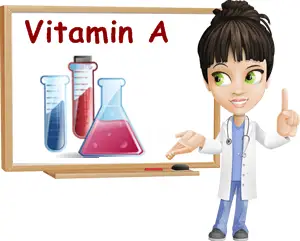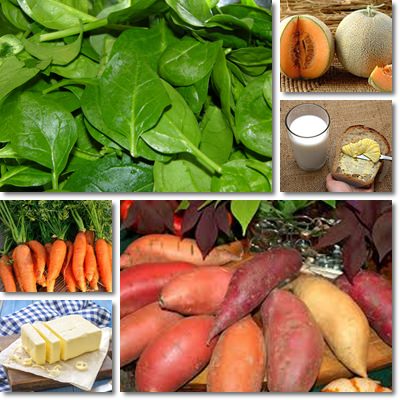Most people are well acquainted with some of the amazing properties of vitamin A and are also aware of the fact that a deficiency of the nutrient may pose serious health risks for vision and immunity in particular. Everyone can tell you the nutrient is great for eye health and can be found in more than generous amounts in carrots. However, vitamin A helps with a variety of functions and benefits multiple systems. It is a powerful antioxidant and can be found in the most surprising of foods.
Vitamin A food sources
The fat-soluble vitamin is commonly found in most green, leafy vegetables such as spinach, cabbage, turnip greens, chard or lettuce and, of course, in orange-colored foods such as sweet potatoes, carrots, pumpkins and orange cantaloupe as well as in butter, egg yolk, dairy and milk, liver, spirulina, fish and fish oils. It has been theorized that animal sources of the nutrient are better than plant sources because they contain animal forms such as retinol, which would be better absorbed, not to mention the fact they contain generous amounts of fats which further enhance absorption.

Types of vitamin A
There are two major types of vitamin A in foods:
- Pro-vitamin A in plant foods. Pro-vitamin A occurs in food in the form of carotene antioxidants, one of two major classes of carotenoid pigments. Pro-vitamin A forms include: beta-carotene, alpha-carotene, beta-cryptoxanthin, and gamma-carotene. Beta-carotene has the most vitamin A activity. Carotenes require fat for optimal absorption.
- Pre-formed vitamin A, or retinol, found exclusively in animal foods. It is used by the body directly as vitamin A and does not require consumption of additional fat considering that animal foods already contain it.
Plant vitamin A versus animal vitamin A
The orange pigments in carrots and other similar foods indicates the presence of carotenes such as beta-carotene and alpha-carotene. Both beta and alpha-carotene are actually plant forms forms of vitamin A and double as antioxidants, as well as perform the same functions as the nutrient-proper. About 40% of carotenes are broken down by the body and converted into vitamin A, while the remaining 60% are used as antioxidants, so you get double the benefits. This is also a reason why beta-carotene dietary supplements are beginning to become as popular as retinol (aka pre-formed vitamin A) supplements.
However, while an excessive intake of retinol from dietary supplements can accumulate in the body and lead to toxicity and other side effects, carotenes have been shown to be harmless even when consumed in higher than recommended amounts.
Our body knows exactly just how much vitamin A it needs to function optimally. This means that it converts as much carotenes as it needs from food and leaves the rest in their unaltered antioxidant form, using them as such. This helps avoid potential toxicity of an excess of vitamin A from plant forms in the body. Excess carotenes thus pose no health risks because they act purely as antioxidants, preventing free radical damage caused by oxidation processes. And antioxidants don’t have an upper limit of consumption so far.

Carotenes come in a variety of forms, the most common being beta-carotene, alpha-carotene, gamma-carotene, beta-cryptoxanthin lycopene etc. Beta-carotene, alpha-carotene, gamma-carotene and beta-cryptoxanthin can be converted into vitamin A (to various degrees), but other carotenes such as lycopene cannot as they do not have vitamin A activity. They nonetheless preserve their antioxidant properties.
As mentioned above, the fat-soluble nutrient in its pure form can be found primarily in animal sources such as butter and milk (excellent sources), chicken, turkey, fish and pork liver, cheese and eggs. However, vegetables sources such as sweet potatoes, carrots, pumpkin, chard, turnip greens, spinach, cabbage, Romaine lettuce, cantaloupe, apricots or papaya also contain potent pro-vitamin A antioxidant carotenes which make them incredibly healthy. However, to facilitate absorption of pro-vitamin A from plant sources you need to eat some fats. Irrespective of the food source it is found in, vitamin A remains a pillar of good health and boasts several wonderful health benefits.
What are the benefits of vitamin A?
Essential for a healthy eyes and good vision
It appears that the nutrient supports retina health, making it possible for us to see in low light and in no light. A deficiency can lead to impaired vision and, ultimately, night blindness, but may encourage other eye-related health issues as well. For example, some experts believe a severe, prolonged shortage of the nutrient may play a role in the early onset of macular degeneration.
Supports the immune system function
Vitamin A reinforces our body’s first line of defense, mucous membranes, and helps strengthen immune defenses against bacteria, viruses and other pathogens. Our eyes, nose, throat, lungs and digestive system all share a common feature: they are lined with mucous membranes. An adequate intake of the nutrient helps keep them in perfect health, preventing tears or breaks that may allows opportunistic bacteria to enter the body and produce infection. Vitamin A is directly involved in skin cell turnover or renewal, hence the reason why it contributes to maintaining healthy mucous membranes. Moreover, our skin benefits just as much from a generous intake despite not being a mucous membrane and helps keep bacteria and viruses away.
Boosts the immune system
Vitamin A strengthens the immune system by supporting the production of lymphocytes. A type of white blood cell, lymphocytes fight off bacteria, viruses, parasites or cancer cells that may make our body sick. Vitamin A deficiency weakens the body’s immunity, resulting in recurrent infections of all sorts, particularly ear or respiratory tract infections. For more information on the benefits of vitamin A on the immune function, see the article 10 vitamins and minerals for good immunity.
Is a potent antioxidant
Carotenes show both vitamin A and antioxidant activity. As antioxidants, they protect cells and DNA against free radical damage that may build up and lead to mutations that may cause certain cells to become cancerous. Having a generous intake of antioxidant carotenes and others prevents excessive damage to cells, potentially lowering the risk for chronic diseases.
Important for healthy babies
According to the Infant and young child feeding fact sheet from the World Health Organization (WHO), nursing babies during the first 6 months of their life supplies them with much needed amounts of vitamin A to help them grow and develop normally as well as develop good immunity. The nutrient is transferred through the mother’s milk and helps the babies meet their daily allowance. Moreover, along with it, antibodies from the mother’s immune system are shared with the baby to keep it healthy while its own immune system slowly develops.
Conclusion
Overall, vitamin A is an essential nutrient with great health benefits. It can be found in both animal and vegetable sources and there are plenty of those to choose from. Some experts recommend us to to meet our daily allowance of the vitamin from fruits and vegetables which also contain carotenoid antioxidants which our body uses both for antioxidant protection and converts into vitamin A. However, animal sources are not to be neglected either because they are a steady supply of the nutrient in its purest form, not to mention contain fats that further ease its absorption.
